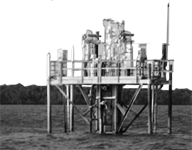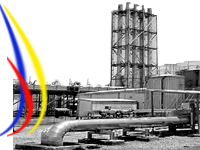Regional Tectonics:
Tanzania is located in an area affected by major tectonic events commencing in the Permo-Triassic with the breakup of Gondwana and continuing to present-day. The development of the post-Gondwana East Africa Continental Margin is separated into two major phases, ?rift and drift?.
Rift Phase (Permian, Triassic and Early Jurassic):.
During the rift stage, the Gondwana continent was split into many parts, which remained in contact with each other. These splits gave rise to basins in which predominantly continental sediments were deposited at relatively high sedimentation rates. During later episodes of extension, sea-floor spreading (drifting) and the development of a passive margin generally followed rifting of continental crust. A few rifts, however, ?failed? and did not progress to the drifting stage.
Drift Phase:
Beginning in the Middle Jurassic, East and West Gondwana separated and East Gondwana broke up into a number of continental plates (India, Antarctica, and Australia). The continental margins of the fragmented continents underwent gradual thermal subsidence, and became repositories for marine sediments as seaward-thickening wedges, which overstep the underlying rift basins. During the late Cretaceous, India began to separate from Madagascar, and this was accompanied by a major episode of igneous activity throughout the Late Cretaceous and Early Tertiary. The rifting between Africa and Arabia commenced in the Oligocene and created ocean crust in the Miocene. The East Africa Rift System propagated in a southerly direction from the Gulf of Aden and has been active since the Miocene.
PCoastal Tanzania:
A combination of four major tectonic events has contributed to the evolution of Coastal Tanzania; a failed NNE rift, a successful NNW rift, an EW graben and the right-lateral drift of Madagascar. The petroleum province is delineated to the east by the Davie Fracture Zone (DFZ) which represents the right-lateral wrench fault along which Madagascar moved. West of this zone, synrift sediments of Triassic to Early Jurassic age overlain by post Middle Jurassic to Recent post rift sequences are preserved. The Selous Basin occupies the failed rift in the southern area of the Coastal Basin. To the north, the rift is occupied by the Ruvu Basin, to the north- west of the Dar es Salaam Platform. The successful rift margin is occupied by the present-day Ruvuma and Mandawa basins, which are situated east of Selous and separated by the Masasi Spur basement high. North of these basins the east-west trending Rufiji Trough cuts across both failed and successful rifts. Offshore Tertiary Basins parallel the coast and are associated with large, down-to-the-basin faults, which demarcate the present coastline. A series of broad troughs and anticlines parallel the coast offshore. The islands of Pemba, Zanzibar, Latham, and Mafia appear to be basement-cored uplifts.
Interior Basins:
These are characterized by half grabens controlled by major boundary faults. Some of these faults exhibit an oblique strike-slip behavior causing flower structure fault deformation. This has resulted in narrow, but very deep, sediment-filled basins exhibiting arange of structural trapping possibilities. The geological map illustrates the present day distribution of outcropping basement rocks and sedimentary basins.

